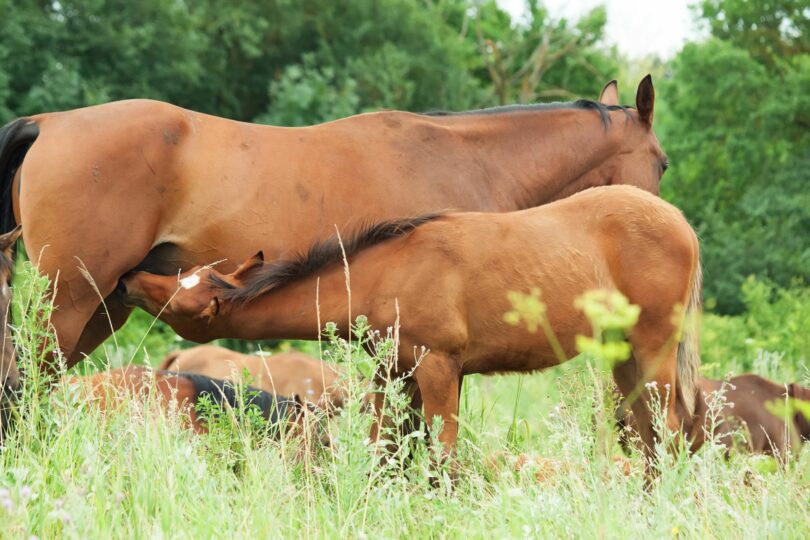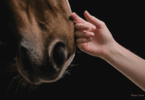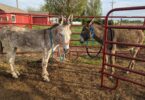Feeding Baby Horses from Birth to Weaning
Is there anything cuter than a foal? Watching their little antics and curiosity about the world around them is one of life’s greatest pleasures for any horse lover! If you’ve ever thought about raising a foal yourself, you may have felt intimidated by all the different things there are to consider, especially related to their diet and nutrition.
When it comes to nutrition for young horses, there are a few key differences compared to feeding an adult horse. From nursing within hours of birth to weaning and transitioning to solid foods, there are a lot of factors to consider.
Baby Horse Basics
As any horse owner who has bred their mare will tell you, producing a healthy foal comes from careful planning and exceptional management of the mare.
Normal mare gestation ranges between 320 and 380 days, but is often closer to 340 days.
Although horses have been foaling unassisted for centuries, complex issues can occur at birth with the potential to result in death for the mare and foal. It’s wise to carefully monitor a pregnant mare for signs of impending labor in case things don’t go smoothly and veterinary assistance is needed.
Some of the signs to watch for include:
- The udder filling and becoming more prominent
- Teats fill with, and may drip, milk
- Musculature under the tail relaxes
- Wax-like substance (colostrum) forms on the end of the teat
There are also test kits you can purchase from your veterinarian. These test kits provide fairly accurate foaling predictions based on the calcium concentration of the mare’s mammary secretions.
Approximately one week before foaling, the mare’s ration should be changed slightly to include more bulk to minimize constipation and reduce the risk of mastitis.
Labor is divided into three stages. The first stage lasts 1-2 hours and ends when the amniotic sac ruptures. Stage two lasts 15-20 minutes, on average, and ends with the foal’s birth. Last, stage 3 ends with the expulsion of the placenta.
The mare and foal will lie down for several minutes following the birth. Foals will generally attempt to stand about 30 minutes after birth. Their efforts generally sever the umbilical cord.
Foal Development & Corresponding Feeds
Along with genetics and management, nutrition can hugely impact proper foal development. Feeding to achieve moderate growth in foals is the best practice, as rapid growth can lead to lifelong muscle and skeletal development issues.
Foals exist solely on the mare’s milk for the first several weeks. If the foal has access to the mare’s grain, they may begin trying it out, but their gut doesn’t have the microbes to break down the grain as a newborn.
By two months, the foal will likely need high-quality forage, grain, and the mare’s milk to grow appropriately. To prevent skeletal issues, foals also need vitamin and mineral supplements, including calcium, phosphorus, selenium, and vitamin E.
Generally, you’ll want to feed one percent of the foal’s body weight daily at this stage of development. Always follow package instructions for feeding and feed by weight rather than volume to prevent overfeeding.
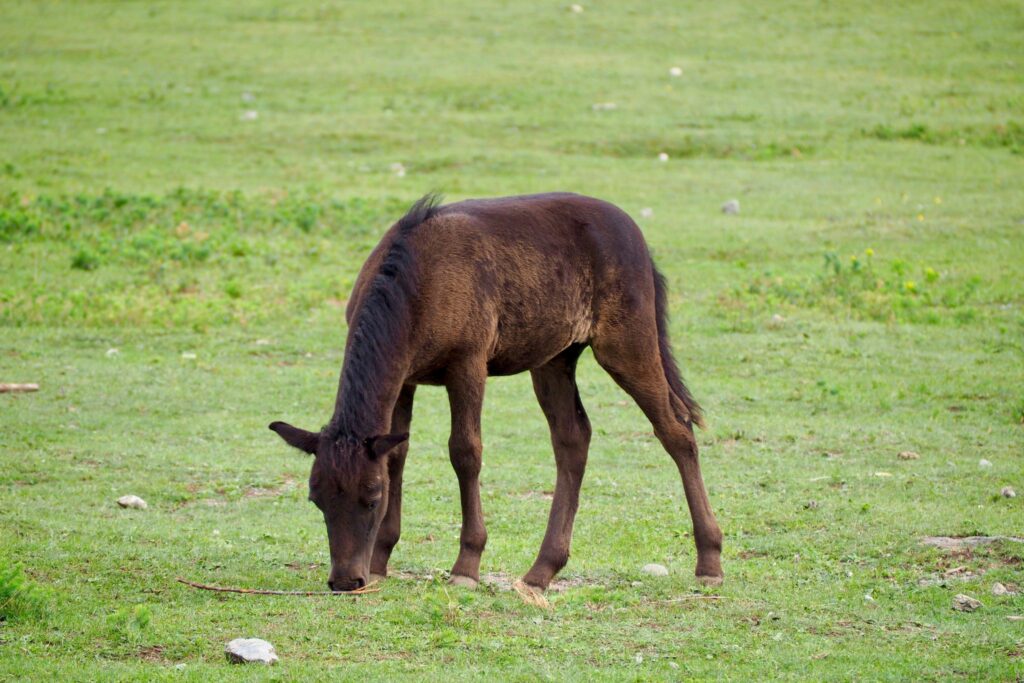
Photo Cred: Canva
Foals should have access to high-quality forage or hay freely. All horses, foals included, should also have access to fresh water at all times. Since foals have small stomachs, it’s best to divide daily feed requirements into at least two or three separate feedings.
Weaning occurs at some point between four and six months of age. The mare’s milk supply will gradually diminish in preparation for weaning.
Increase the foal’s ration gradually during this period. Conversely, the mare’s ration should be decreased to encourage the end of lactation. Once weaned, the foal will need between 2% and 3% of its body weight daily in feed; this may come from a combination of both forage and concentrate feed (grain).
Nursing
A foal should attempt to nurse within 3 hours of birth. If the foal hasn’t nursed within this time frame, it may need veterinary intervention.
The very first milk produced by the mare is called colostrum. This is vital for immune function, as it provides crucial antibodies to the foal via passive transfer. Mares only produce colostrum after foaling.
The Importance of Colostrum:
Colostrum contains antibodies to help boost the foal’s immune system, as they are born without antibodies. It is specific to the mare’s environment and the bacteria and viruses the foal might encounter.
A foal has only a short window to absorb the antibodies. If a foal hasn’t nursed within 8 hours of birth, they are at serious risk of infection. Based upon that risk, they may need additional veterinary help with their immunity.
Some tests can be used to ensure the foal has received sufficient antibodies. If in doubt, contact your veterinarian as soon as possible.
In addition to antibodies, colostrum contains vitamins, minerals, protein, fat, and even a laxative to encourage the foal’s first stool.
Foals begin making their own antibodies between 3-6 weeks of age but continue receiving immune support from the mare’s milk until 4 or 5 months of age.
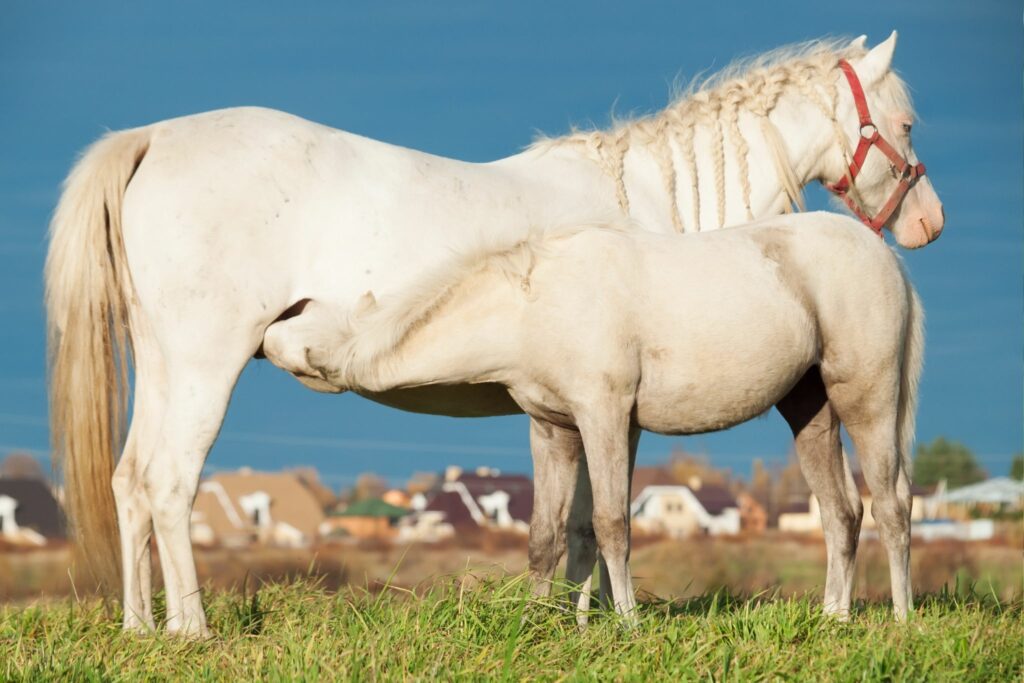
Photo Cred: Canva
What is the best feed for foals?
Commercially prepared feeds are always formulated for specific life stages. Although several feeds are available on the market, look for one specifically designed to address the needs of a growing foal.
What do you feed an orphaned foal?
A commercial horse milk replacer is the best option for feeding an orphaned foal. They can administer equine plasma to ensure adequate immune protection. Contact your veterinarian immediately if the mare dies before the foal receives colostrum.
The foal should receive between 20 and 25 percent of its body weight in milk daily. Foals should be fed about every 2 hours during the day and every 3 hours at night for the first couple of weeks.
Aim for an approximate 2-pound increase daily. Gradually add high-quality forage and grain as you would for a foal nursed by a mare.
Introduction of Solid Foods
Many foals will start testing out the mare’s feed when they are only a few weeks old.
The amount fed to the foal will gradually increase over the next several months while the amount provided to the mare will decrease.
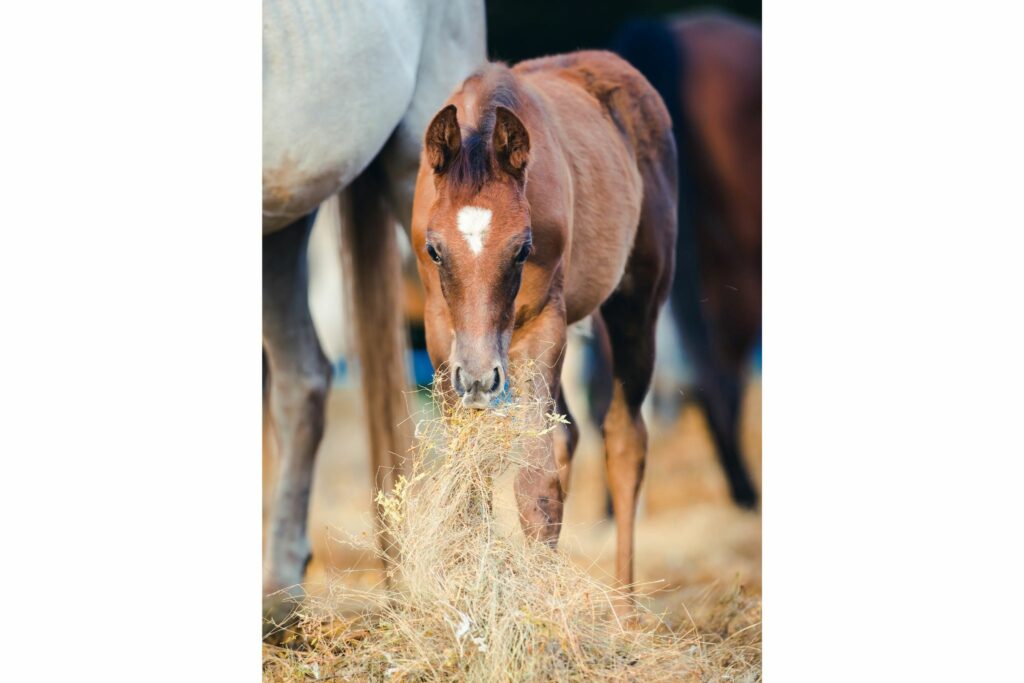
Photo Cred: Canva
When do foals get teeth?
Similar to humans, horses develop “baby teeth,” which are later replaced with permanent ones. Foals are generally born without teeth but develop their first baby teeth within about 8 days.
By 6 months of age, the permanent teeth begin to replace the baby ones, and by a year, the horse will have around 24 permanent teeth.
Weanling
Between 4 and 6 months of age, the mare will begin producing less milk, and the foal will be weaned.
When do foals start eating grass?
Foals may start nibbling at grass within a couple of weeks. Forage and grain become staples of their diet within the first several months.
When do foals start eating grain?
Foals may try the mare’s grain within the first couple of weeks.
Yearling
By 12 months of age, yearlings have been completely weaned off milk. They may also have reached 90 percent of their mature height.
Bone development lags behind height, and horses at this growth stage require high-quality feed to promote steady growth. It’s essential to avoid overfeeding a yearling because doing so can cause significant joint and bone problems.

Photo Cred: Canva
What are the best feeds for foals?
When searching for feeds, always look for one designed specifically for your horse’s life stage. A feed designed for an older horse would not necessarily be appropriate for a foal. Nutrient profiles of different concentrates can vary dramatically.
Three feeds formulated for young, growing horses are:
- Purina Omolene #300 Growth Horse Feed
- Nutrena SafeChoice Mare and Foal Pellet
- Triple Crown Growth Textured Feed
Frequently Asked Questions
Q: Do baby horses drink milk?
Yes. Foals nurse from the mare until between 4 and 6 months of age.
Q: What do you feed a newborn horse?
Newborn horses get all their nutritional needs from the mare’s milk. They may start testing out grass, hay, and grain within only a few weeks but won’t have the ability to actually digest nutrients from these feed sources right away.
Q: What do baby foals eat?
Newborn foals only need the mare’s milk in the very beginning. They will gradually begin testing grain, grass, and hay within a couple of weeks. With exposure to different feed sources, they will eventually develop the enzymes and bacteria necessary to break feed down so their body can use the nutrients.
Q: When do foals start drinking water?
There isn’t one definitive answer to this question, as each foal is different. Foals generally start drinking water at some point between 3 weeks and weaning. Suppose you notice a nursing foal visiting the water trough frequently. In that case, it can signify that they need more milk.
Weighing a foal regularly can help you track growth. If you’re questioning whether the foal is getting enough nutrients from milk, contact your veterinarian for further guidance.
Q: What age can foals eat carrots?
A foal should be well-established on forage and grain before you begin offering extra treats. It’s wise to wait until they have been weaned to offer carrots.
Carrots should be offered in moderation and washed thoroughly before feeding to your horse. Even if your weanling has teeth, it’s best to cut the carrot into smaller pieces to avoid choking. You can also shred the carrot and sprinkle it on your horse’s grain.
Although many horses love carrots, they are a treat and should always be fed in moderation.
Parting Thoughts
Baby horses have their own, specific nutritional needs and require extra care and attention to ensure they develop properly. It’s essential to offer a balanced diet appropriate for the foal’s life stage rather than overfeeding them too early.
Always consult your veterinarian if you have any questions or concerns about feeding your foal.
Understanding when and what to feed foals can help set them up for lifelong success.
P.S. Enjoy this article? Trot on over to:
- Mares and Foals: How to Feed Breeding Stock for Success
- Foal Math: How Many Babies Can a Mare Have?
- 3 Types of Horse Feed Every Owner Should Understand
- 30+ Equine Nutrition Terms Your Horse Wishes You Knew
- Bundles of Joy: How Much Do Newborn Horses Weigh?
- Breeding Basics: Understanding the Equine Pedigree
- Baby Brain: Horse Breeding Terminology for Beginners
- The Udder Truth: Do All Horses Have Them?
Sources
- Horse Foaling Management Guidelines | Extension Horses
- Foal Growth: Special Care and Nutrition | AAEP
- Why do foals need colostrum? (umn.edu)
- Feeding orphaned foals (umn.edu)
- Foal Horse Nutritional Needs | Purina Animal Nutrition (purinamills.com)
- Omolene 300 Growth Concentrate Horse Feed | Purina (purinamills.com)
- Are Baby Horses Born With Teeth? Foal And Yearling Dental. (horseracingsense.com)
- SafeChoice Mare & Foal Horse Feed | Nutrena (nutrenaworld.com)
- Q&A: Drinking Behavior of Foals – Kentucky Equine Research (ker.com)

